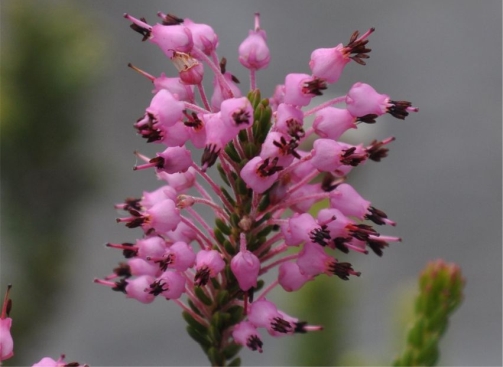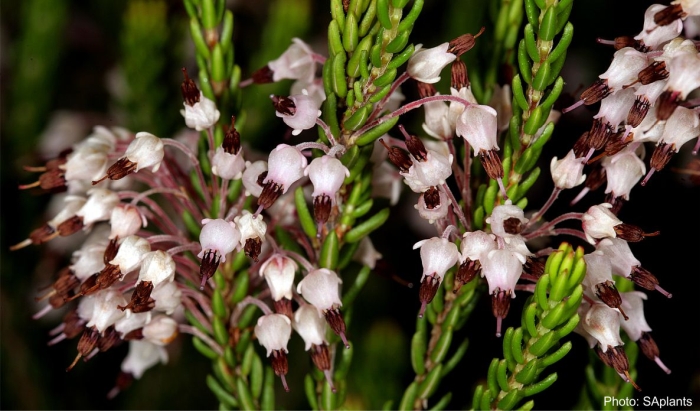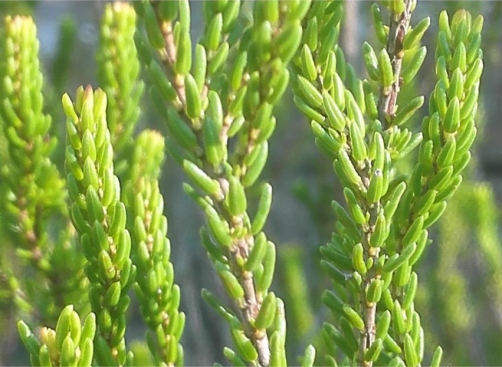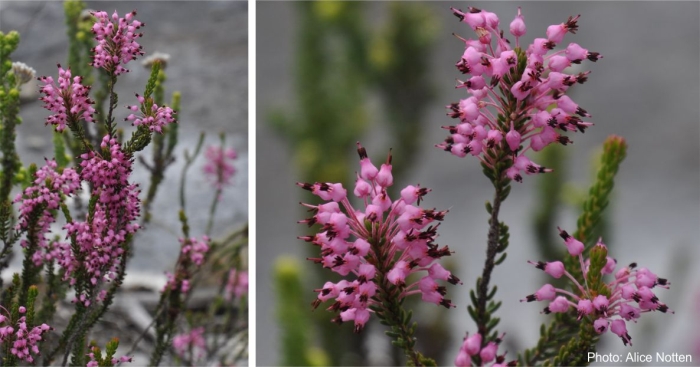Erica scytophylla
Erica scytophylla Guthrie & Bolus
Family: Ericaceae
Common names: leather-leaf heath (Eng.); leerblaarheide (Afr.)
Introduction
This shrub produces white or pink flowers in spring and early summer, usually from September to December, and is ideal for container planting.

Description
Description
Erica scytophylla grows upright and reaches a height of up to 1.5 metres. The 3-nate leaves are ± 6 mm long and are conspicuously thick and leathery, and densely cover the whole length of the branches. The leaves point upwards and are usually incurved or overlapping, the younger leaves appear elliptical or oblong whereas the older leaves are longer, narrowly oblong and smooth. The small, urn-shaped, pink or white flowers with dark, exserted anthers are borne at the tip of the branches from winter to early summer (June to December).

Conservation Status
Status
Erica scytophylla is not threatened, it has a conservation status of least Concern (LC).
Distribution and habitat
Distribution description
This plant is a South African endemic and is usually found growing on limestone-derived soils in the region of Bredasdorp and Cape Infanta. Erica scytophylla is present also in a white form, with white flowers, which is found mainly in the lower-lying and sandy areas around De Hoop and is a vigorous grower.

Derivation of name and historical aspects
History
The genus name Erica is derived from the Greek word ereiko, which means ‘to break’, this could refer to the stems of the plant that breaks or tear easily. The specific epithet is made up of two Greek words, skytos, which means ‘skin’ and the second part, phyllon, which means ‘leaf’ and together refers to the leathery texture of the leaves.

Ecology
Ecology
Heath seeds, which are usually very small, can remain viable for long periods in the soil bank, in nature they will germinate when conditions become favourable, such as at the right temperature and soil moisture level. Erica scytophylla is pollinated by insects, by moving from one flower to the other as they feed on the nectar and/or pollen, the insects assist in carrying out the process of pollination.
Uses
Use
Like most ericas, Erica scytophylla makes an excellent companion plant when planted in garden beds with other fynbos species such as those in the Restionaceae, Proteaceae and the Rutaceae families. This plant is also ideal for container planting, provided that the soil medium is in the acidic range and drains well.

Growing Erica scytophylla
Grow
Erica scytophylla grows well in soil with a pH ranging from 5.5–6.7 and prefers a sunny position. Regular pruning will encourage new growth and flowering, the plant responds best to feeding with an organic liquid fertilizer.
Take ± 40–50 mm cuttings 2 months after flowering, and take heel or nodal cuttings from semi-hardwood, apply a rooting hormone for semi-hardwood cuttings. Use a rooting medium of fine-milled bark and polystyrene chips at a 50:50 ratio to put the cuttings in. This plant can be successfully rooted in greenhouse conditions with a misting system and a constant bottom heat of 24°C. Transplant the rooted cuttings into small pots (about 9 cm) in a soil mixture of 8 parts bark and 3 parts sand, and water thoroughly. Feed with an organic liquid fertilizer, preferably a fish emulsion type, every 2 weeks. The cuttings will be ready to be planted out after about 3 months.
Sow seeds in autumn, around April and May, when the temperature starts to become cooler. Mix river sand and sifted composted bark in a 50:50 ratio and add to a 100 mm deep seed tray and level it. Use fine river sand to mix with the seeds and broadcast it on top of the levelled mix, cover it lightly with some of the mixed sand. Keep the medium moist by watering with a fine hose. The seeds will start to show signs of germination after about 2 months. Transplant the seedlings into small pots once they are 10 mm in height.
Control thrips and scale insects by applying an appropriate pesticide product and following the directions for application closely. Preventative measures such as not sowing seeds too dense and to maintain good air circulation can prevent fungal attacks.
References
- Goldblatt, P. & Manning, J. 2000. Cape Plants. A conspectus of the Cape flora of South Africa. Strelitzia 9. National Botanical Institute, Pretoria & Missouri Botanical Garden, Missouri.
- Pienaar, K. & Smith, G.F. 2011. The southern African what flower is that? An essential guide to garden plants. Struik, Cape Town.
- Raimondo, D., Von Staden, L., Foden, W., Victor, J.E., Helme, N.A., Turner, R.C., Kamundi, D.A. & Manyama, P.A. (eds) 2009. Red list of South African plants. Strelitzia 25. South African National Biodiversity Institute, Pretoria.
- Rourke, J.P. 1980. Wild flowers of South Africa. C. Struik Publishers, Cape Town.
- SAplants, Wikimedia Commons, CC-BY-SA 4.0. https://commons.wikimedia.org/wiki/Category:Photographs_by_SAplants.
- Schumann, D., Kirsten, G. & Oliver, E.G.H. 1992. Ericas of South Africa. Fernwood Press, Vlaeberg.
- Smith, C.A. 1966. Common names of South African plants. Memoirs of the Botanical Survey of South Africa No. 35. Government Printer, Pretoria.
- Stearn, W.T. 1992. Stearn’s Dictionary of Plant Names for gardeners. A handbook on the origin and meaning of the botanical names of some cultivated plants. Cassell, UK.
- WFO. 2022. Erica scytophylla Guthrie & Bolus. Published on the Internet. http://www.worldfloraonline.org/taxon/wfo-0000673216. Accessed 07 Aug 2022.
Credits
Benjamin Festus
Kirstenbosch National Botanical Garden
August 2022
Acknowledgements: additional images by Alice Notten and SAplants.
Plant Attributes:
Plant Type: Shrub
SA Distribution: Western Cape
Soil type: Sandy, Loam
Flowering season: Spring, Early Summer, Winter
PH: Acid, Alkaline, Neutral
Flower colour: Brown, White, Pink
Aspect: Full Sun
Gardening skill: Average
Special Features:
Horticultural zones








Rate this article
Article well written and informative
Rate this plant
Is this an interesting plant?
Login to add your Comment
Back to topNot registered yet? Click here to register.